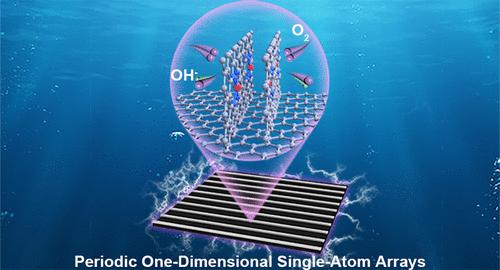当前位置:
X-MOL 学术
›
J. Am. Chem. Soc.
›
论文详情
Our official English website, www.x-mol.net, welcomes your
feedback! (Note: you will need to create a separate account there.)
Periodic One-Dimensional Single-Atom Arrays
Journal of the American Chemical Society ( IF 14.4 ) Pub Date : 2022-08-23 , DOI: 10.1021/jacs.2c05572
Lingxiao Wang 1 , Jing Wang 2 , Xiaoping Gao 1 , Cai Chen 1 , Yunli Da 3 , Sicong Wang 4 , Jia Yang 1 , Zhiyuan Wang 1 , Jia Song 1 , Tao Yao 4 , Wu Zhou 3 , Huang Zhou 1 , Yuen Wu 1, 5
Journal of the American Chemical Society ( IF 14.4 ) Pub Date : 2022-08-23 , DOI: 10.1021/jacs.2c05572
Lingxiao Wang 1 , Jing Wang 2 , Xiaoping Gao 1 , Cai Chen 1 , Yunli Da 3 , Sicong Wang 4 , Jia Yang 1 , Zhiyuan Wang 1 , Jia Song 1 , Tao Yao 4 , Wu Zhou 3 , Huang Zhou 1 , Yuen Wu 1, 5
Affiliation

|
The orderly assembly of single atoms into highly periodic aggregates at the nanoscale is an intriguing but challenging process of high-precision atomic manufacturing. Here, we discover that an in-plane film surface shrinkage can induce molecular self-assembly to arrange single atoms with unconventional distribution, contributing them to periodic one-dimensional segregation on carbon stripes (one-dimensional single-atom arrays (SAA)). This originates from the fact that metal phthalocyanine (MPc) molecules gradually aggregate and melt to form a film under a thermal drive and the help of sodium chloride templates, accompanied by surface shrinkage, self-assembly, and deep carbonization. At the nanoscale, these periodic parallel arrays are formed due to MPc molecular interactions by π–π stacking. At the atomic scale, the single atoms are stabilized by the vertical phthalocyanine-derived multilayer graphene. This can significantly modify the electronic structure of the single-atom sites on the outermost graphene (e.g., Fe-based SAA), thus optimizing the adsorption energy of oxygen intermediates and resulting in a superior oxygen reduction reaction (ORR) performance concerning disordered single atoms. Our findings provide a general route for orderly single-atom manufacturing (e.g., Fe, Co, and Cu) and an understanding of the relationship between orderly allocation and catalytic performance.
中文翻译:

周期性一维单原子阵列
将单个原子有序组装成纳米尺度的高度周期性聚集体是高精度原子制造的一个有趣但具有挑战性的过程。在这里,我们发现平面内薄膜表面收缩可以诱导分子自组装以排列具有非常规分布的单个原子,从而促成它们在碳条纹上的周期性一维偏析(一维单原子阵列(SAA))。这是由于金属酞菁(MPc)分子在热驱动和氯化钠模板的帮助下逐渐聚集熔化形成薄膜,并伴随着表面收缩、自组装和深度碳化。在纳米尺度上,这些周期性平行阵列是由于 MPc 分子相互作用通过 π-π 堆叠形成的。在原子尺度上,单个原子由垂直的酞菁衍生的多层石墨烯稳定。这可以显着改变最外层石墨烯(例如,Fe基SAA)上单原子位点的电子结构,从而优化氧中间体的吸附能,并在无序单原子上产生优异的氧还原反应(ORR)性能. 我们的研究结果为有序的单原子制造(例如,Fe、Co 和 Cu)提供了一般途径,并理解了有序分配与催化性能之间的关系。从而优化氧中间体的吸附能,并在无序单原子方面产生优异的氧还原反应(ORR)性能。我们的研究结果为有序的单原子制造(例如,Fe、Co 和 Cu)提供了一般途径,并理解了有序分配与催化性能之间的关系。从而优化氧中间体的吸附能,并在无序单原子方面产生优异的氧还原反应(ORR)性能。我们的研究结果为有序的单原子制造(例如,Fe、Co 和 Cu)提供了一般途径,并理解了有序分配与催化性能之间的关系。
更新日期:2022-08-23
中文翻译:

周期性一维单原子阵列
将单个原子有序组装成纳米尺度的高度周期性聚集体是高精度原子制造的一个有趣但具有挑战性的过程。在这里,我们发现平面内薄膜表面收缩可以诱导分子自组装以排列具有非常规分布的单个原子,从而促成它们在碳条纹上的周期性一维偏析(一维单原子阵列(SAA))。这是由于金属酞菁(MPc)分子在热驱动和氯化钠模板的帮助下逐渐聚集熔化形成薄膜,并伴随着表面收缩、自组装和深度碳化。在纳米尺度上,这些周期性平行阵列是由于 MPc 分子相互作用通过 π-π 堆叠形成的。在原子尺度上,单个原子由垂直的酞菁衍生的多层石墨烯稳定。这可以显着改变最外层石墨烯(例如,Fe基SAA)上单原子位点的电子结构,从而优化氧中间体的吸附能,并在无序单原子上产生优异的氧还原反应(ORR)性能. 我们的研究结果为有序的单原子制造(例如,Fe、Co 和 Cu)提供了一般途径,并理解了有序分配与催化性能之间的关系。从而优化氧中间体的吸附能,并在无序单原子方面产生优异的氧还原反应(ORR)性能。我们的研究结果为有序的单原子制造(例如,Fe、Co 和 Cu)提供了一般途径,并理解了有序分配与催化性能之间的关系。从而优化氧中间体的吸附能,并在无序单原子方面产生优异的氧还原反应(ORR)性能。我们的研究结果为有序的单原子制造(例如,Fe、Co 和 Cu)提供了一般途径,并理解了有序分配与催化性能之间的关系。

































 京公网安备 11010802027423号
京公网安备 11010802027423号